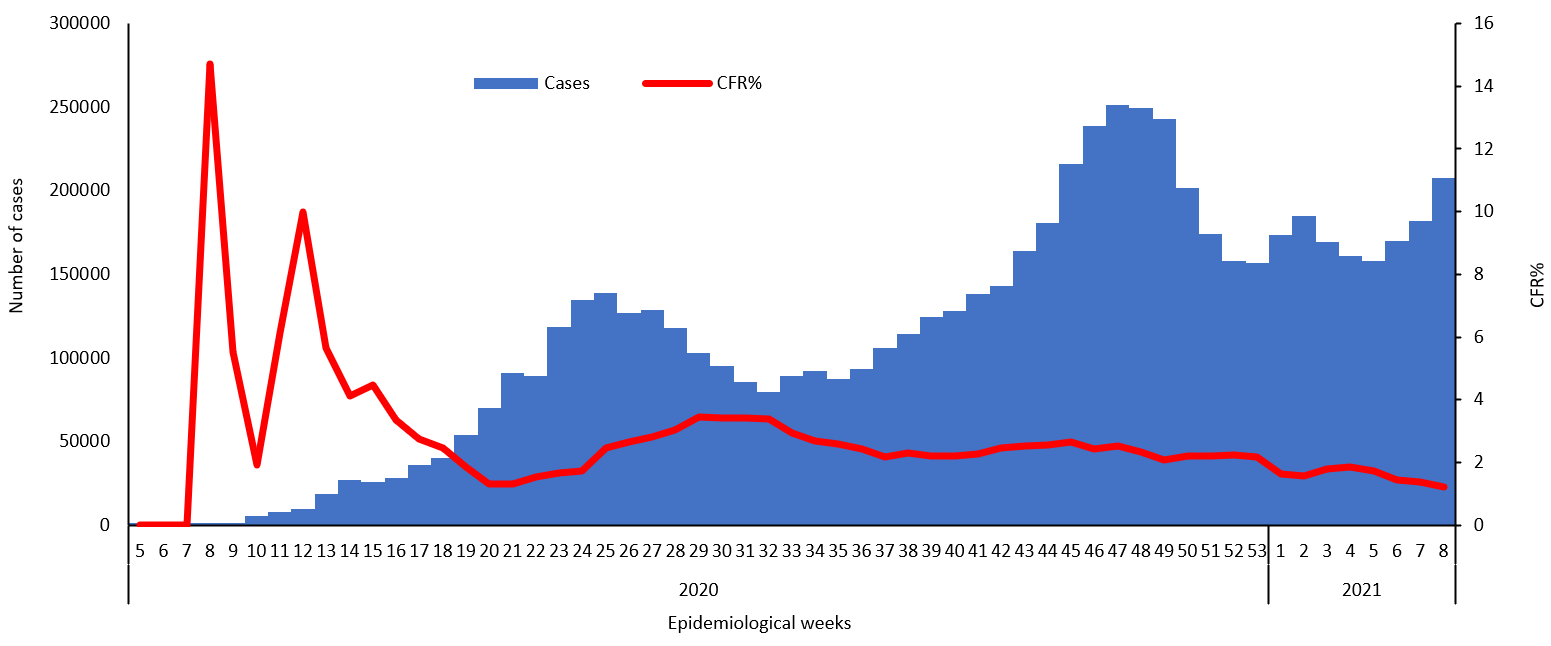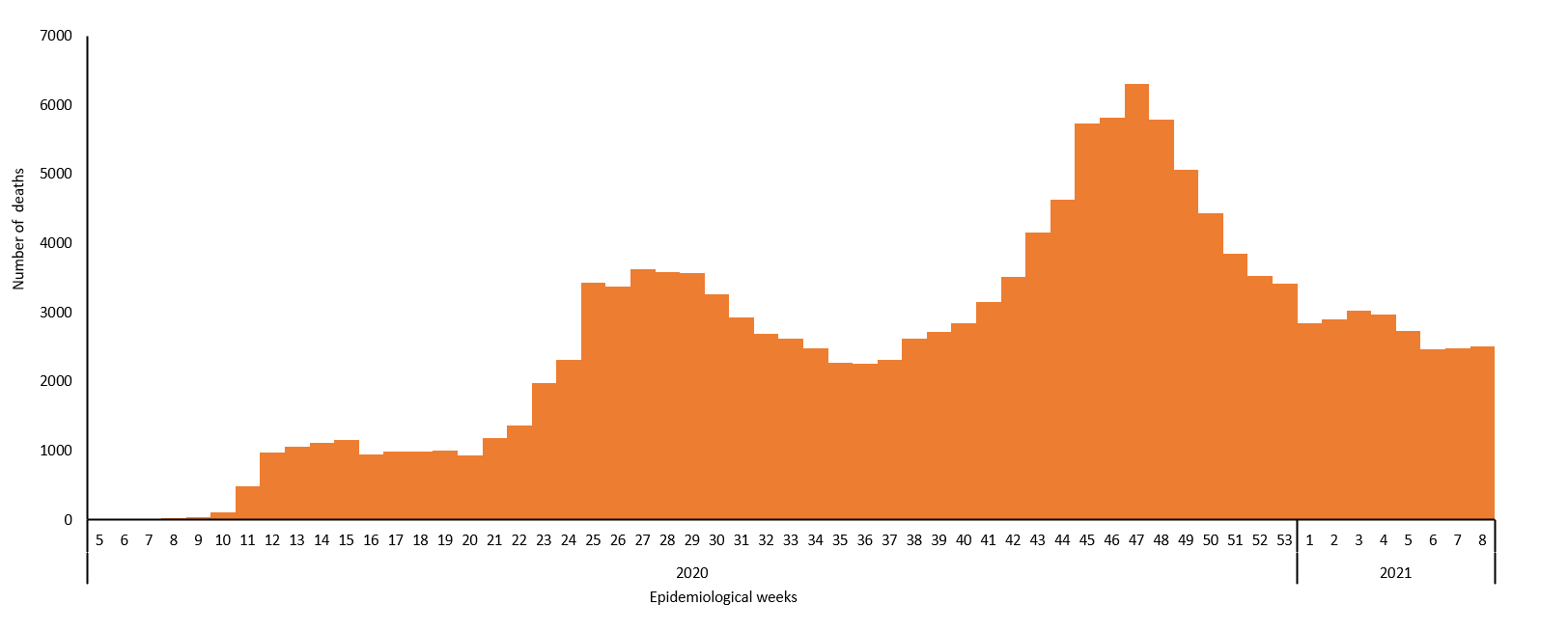The coronavirus disease COVID-19 continues to spread at the regional and global levels. As of 27 February 2021, the global cumulative incidence reached 113 085 763 reported cases and 2 512 321 associated deaths with a case fatality ratio (CFR) of 2.2%. Meanwhile, the 22 countries of the Eastern Mediterranean Region (EMR) have reported a total of 6 183 632 cases, which represent about 5.5% of the global count, with 144 535 associated deaths (CFR 2.3%). Most countries in the Region are in the community transmission phase.
Since the beginning of the outbreak, the country that has reported the highest number of total cases in the Region is Islamic Republic of Iran (1 623 159 cases; 25.4% of the Region’s total), followed by Iraq (692 241; 10.8%) and Pakistan (579 973 ; 9.1%). Islamic Republic of Iran also reported the highest number of total associated deaths (59 980; CFR 3.7%) followed by Iraq (13 383; CFR 1.9%) and Pakistan (12 860; CFR 2.2%). The highest CFRs were reported by Yemen (27.8%) followed by Syrian Arab Republic (6.6%), while the lowest CFRs were reported by Qatar (0.2%) followed by United Arab Emirates (0.3%) and Bahrain (0.4%).
During epidemiological week 8, the Region reported an increase of 14% in cases when compared to the previous week (207 371 cases compared to 181 922 cases). Similarly, a 1.1% increase was observed for associated deaths (2510 deaths compared to 2482 deaths).
Somalia, Jordan and occupied Palestinian territory (oPt) reported a relative increase in COVID-19 activity in week 8. The cumulative number of cases increased from 5889 to 6991 in Somalia (18.7% weekly increase), from 359 811 to 386 496 in Jordan (7% weekly increase) and from 194 875 to 206 438 in oPt (5.9% weekly increase). Somalia, United Arab Emirates and Lebanon had the largest relative increase in deaths.
In terms of testing, a total of 97 095 300 laboratory PCR tests were conducted since the start of the outbreak across the Region including 3 270 233 tests in week 8, which shows a 2% increase compared to the previous week (3 197 386). The highest number of PCR tests were reported from United Arab Emirates (30.4 million), followed by Saudi Arabia (13.6 million) and Islamic Republic of Iran (10.8 million). The United Arab Emirates and Bahrain are performing the highest rates of testing per capita (3078/1000 and 1809/1000, respectively). The average positivity rate for the Region is 6.6%. WHO recommends a positivity rate of around 3–12% as a general benchmark indicating adequate testing, which was achieved in most countries of the Region.
Meanwhile, COVID-19 vaccination has started in the Region. The total number of doses administered so far in 13 countries include 6 020 461 in United Arab Emirates, 3 597 903 in Morocco, 780 667 in Saudi Arabia, 295 296 in Bahrain, 175 000 in Kuwait, 100 000 in Qatar, 60 913 in Oman, 72 882 in Pakistan, 70 109 in Jordan, 34 989 in Lebanon,10 000 in Iran, 4871 in oPt and 1315 in Egypt. Afghanistan has also reportedly started vaccinations.
Supporting countries in the Region
The regional incident management support team continues to coordinate the response and provide technical support to countries and partners in the Region in the areas of coordination and partnership, surveillance, laboratory capacity, clinical management, infection prevention and control, risk communication and community engagement, points of entry according to the International Health Regulations (2005), research, health systems, and essential health services among others. Activities this week included:
organizing a workshop on assessment of essential medicines to implement national sexual and reproductive health guidelines in Afghanistan, Iraq, Lebanon, Morocco and Pakistan; and
organizing a capacity building workshop on “implementation research methods and ethics” on 23–25 February 2020 that including grantees from 8 countries of the Region.


For more data from the Region, please visit the COVID-19 dashboard.
Subscribe to the monthly infectious hazard preparedness newsletter of WHO’s Health Emergencies Programme for latest data and analysis on epidemic- and pandemic-prone diseases, as well as news on outbreak preparedness and response within WHO’s Eastern Mediterranean Region.








